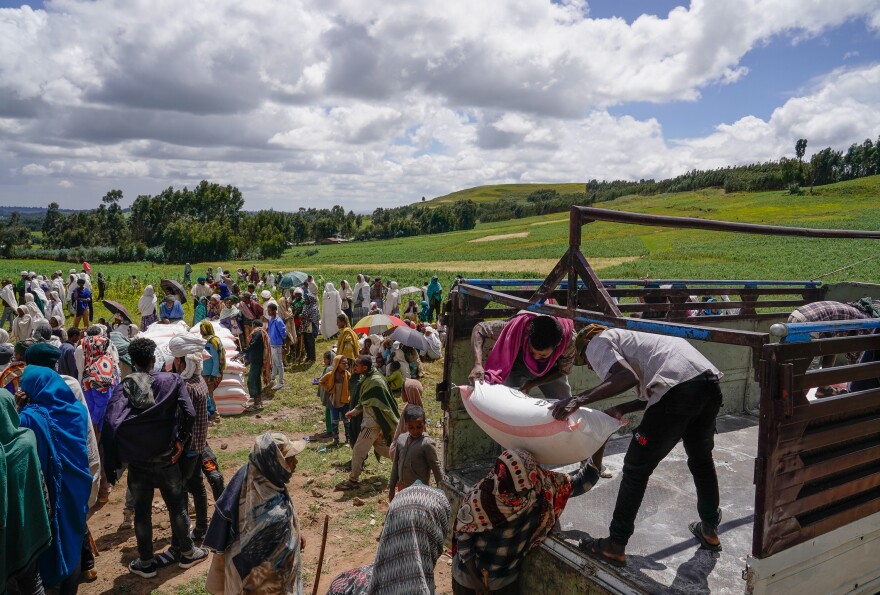The head of the World Health Organization has a stark message for the world. On the one hand, said Tedros Adhanom Ghebreyesus at a press conference last week, the focus on the victims of Russia's war on Ukraine is entirely justified and necessary. But on the other hand, he added, the international community is failing to give even "a fraction" of that attention to people in countries far beyond Ukraine who are grappling with ripple effects of the war that are just as devastating. Specifically, millions of people around the globe are being pushed into hunger due to the reduction in exports of wheat and other key food items from Ukraine and Russia – two of the world's biggest suppliers.
"I don't know if the world really gives equal attention to black and white lives," said Tedros. "And I need to be blunt and honest that the world is not treating the human race the same way."
It was the latest expression of alarm by aid officials as they point to growing evidence of the war's impact on global hunger. To find out how this is playing out on the ground, NPR spoke with Bob Kitchen, vice president of emergencies for the aid group International Rescue Committee. Here are four takeaways.
1. Food prices are already spiking
It's hard to pinpoint the war's precise effects because it has hit amid so many other calamities. These include a series of droughts in various parts of the world that had already driven up food prices to record levels, and lingering economic fallout from the pandemic that had already cut into many people's ability to afford those higher prices. However, it's clear that the war has made this already bad picture worse. Take the United Nations Food and Agriculture Organization's "food price index." Between February and March it spiked by 12%, to its highest level since the U.N. created the index back in 1990. To see an effect like that "is concerning given that we're only six weeks into the war," says Kitchen.
2. The price rise is already forcing more people to miss meals.
Since the war began, says Kitchen, "we are seeing the number of people who are food insecure and in urgent need of food aid rising rapidly across at least four areas of the world that we are monitoring. There's been alarming growth in the number of people who are growing hungry."
Worst hit are those places that were already struggling. For instance, in Afghanistan a month ago 55% of the population was facing crisis levels of food insecurity. Now it's gone up 10 points to 65%.
Kitchen says it's important to understand just what this type of "crisis level" hunger looks like. On a visit to Afghanistan last month, he notes, "I was hearing from mothers who were saying that they didn't have the food sufficient to be able to feed their families except for every three days. So two out of three days, they weren't able to feed their family."
West Africa is also in a very dangerous state. Right now 27 million people are going hungry in countries such as Nigeria, Burkina Faso, Niger, Chad and Mali. But Kitchen points to a prediction by a consortium of aid organizations that by June, 11 million more people will fall into that status.
There is also substantial hunger in Somalia, Kenya and Ethiopia — where the humanitarian crisis has been particularly grim due to the conflict in the Tigray region. There, says Kitchen, "the combined numbers are in the tens of millions of people who are facing crisis levels of food insecurity."
3. This can be solved with money.
Kitchen says that even with the loss of food from Ukraine and Russia, there is still technically enough food to feed everyone. In other words, the problem is not so much the reduced supply, but rather how the reduction drives up costs. "Food is available, but it's way more expensive than the most vulnerable portions of the population can afford," says Kitchen. And this means that if people can be provided with cash to cover the difference, they will be okay. "In many places our interventions are just cash-based programs."
4. The humanitarian crisis in Ukraine is cutting into aid dollars for other regions.
Unfortunately these kinds of cash-based programs are already woefully underfunded, says Kitchen. For instance in the case of West Africa, "there's an immediate $4 billion funding gap for the United Nations' appeal for [the region]. So it's a very big number."
And it appears that the war in Ukraine has exacerbated the problem. While there's been an outpouring of donations for Ukraine, we've started to see government donors reprioritize money away [from African countries.] Scandinavian countries have already halved the contributions in the year to come – retasking to put [the money] into Ukraine."
And so Kitchen's call to wealthy donor countries echoes Tedros's: "New emergencies such as Ukraine demand new funding rather than just repurposed funding," he says. "Otherwise we're just taking food out of the mouths of children in Burkina Faso and Niger and putting it in the mouths of children from Ukraine. One is not more deserving than the other."
Copyright 2022 NPR. To see more, visit https://www.npr.org.




